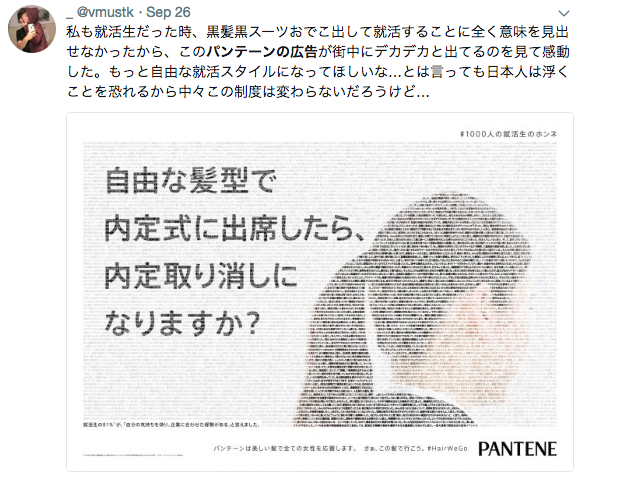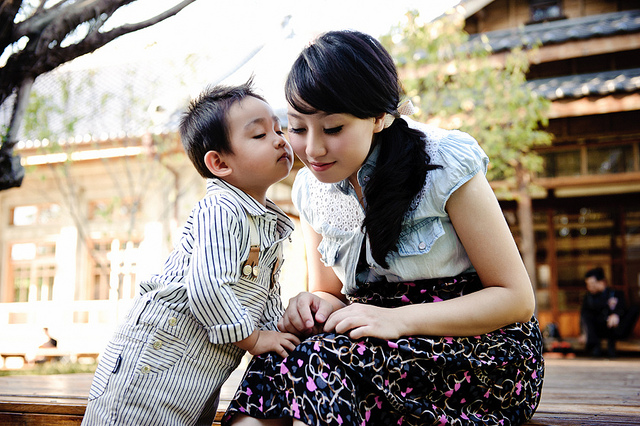feminism
Sexy schoolgirl or stylized kimono-clad character? Which is better for advertising agricultural products?
Otaku, artists, feminists, and a Tokyo assemblyman weigh in on the controversial crotch-revealing image.
Hair care brand shines a light on outdated practice that forces women to sport the “job-hunting hairstyle” in order to gain employment.
The status of women in Japan is changing and the Japanese language is being modified along with it. Let’s see how women are viewed these days by surveying some of the modern Japanese words used to describe them.
The new ad campaign addresses a variety of behaviours that should be avoided while travelling on trains, but so far, this is the only act that they’re calling indecent.
Although the protester that managed to infiltrate the European Central Bank’s monthly press conference recently got plenty of media attention with her clever deployment of a so-called “Glitter Bomb” – that is, she scattered the notoriously-difficult-to-remove, fabulous substance everywhere – her protest method of choice came a few months too late.
Everyone knows, of course, that the disruptive substance du jour now is the dial-a-bag of dongs. Glitter is just so yesterday. But, our intrepid protester is still getting her due time in the spotlight in Japan because of her resemblance to a certain anime character.
It’s no secret that Japan continually lands at the bottom in global gender gap reports. In 2012, the World Economic Forum ranked Japan 101 in regard to women’s participation in the economy and politics. In 2013, Japan placed 105 (out of 135 countries), putting it behind Burkina Faso in gender equality.
Based on these findings, you may think it doesn’t seem like Japan is a very good country for women, but you’d be wrong. While there are huge shortcomings in gender gaps in the workplace, economy and politics, in other sectors of Japanese society some would would argue that Japanese women have “too much” power.
Let’s take a look at five areas where women are most powerful in Japan.









 7-Eleven Japan’s ramen-cooking robot whipped us up a bowl of noodles【Taste test】
7-Eleven Japan’s ramen-cooking robot whipped us up a bowl of noodles【Taste test】 Hello Kitty Choco Egg figures are an adorable trip through three periods of Japanese pop culture【Pics】
Hello Kitty Choco Egg figures are an adorable trip through three periods of Japanese pop culture【Pics】 Japan’s otoshidama tradition of giving kids money at New Year’s gets a social welfare upgrade
Japan’s otoshidama tradition of giving kids money at New Year’s gets a social welfare upgrade Dragon Quest Burgers and Slime drinks are coming to McDonald’s Japan【Video】
Dragon Quest Burgers and Slime drinks are coming to McDonald’s Japan【Video】 Japanese convenience store Family Mart adding crane games to thousands of branches
Japanese convenience store Family Mart adding crane games to thousands of branches Once you hear this lady sing “Yooooooghurppe”, you may never stop hearing it
Once you hear this lady sing “Yooooooghurppe”, you may never stop hearing it Drunk cycling can result in an instantly suspended driver’s license in Japan
Drunk cycling can result in an instantly suspended driver’s license in Japan Senkoji: The Japanese temple that’s more like a theme park to heaven and hell
Senkoji: The Japanese temple that’s more like a theme park to heaven and hell New smartphone game lets you date real-life J-pop idols, but shockingly gives them 100 Boyfriends
New smartphone game lets you date real-life J-pop idols, but shockingly gives them 100 Boyfriends Bear bites butt in Japan as ursine assaults continue
Bear bites butt in Japan as ursine assaults continue 7-Eleven Japan starts new temporary luggage storage service in over 300 branches
7-Eleven Japan starts new temporary luggage storage service in over 300 branches Disillusionment at Tsukiji’s tourist-target prices led us to a great ramen restaurant in Tokyo
Disillusionment at Tsukiji’s tourist-target prices led us to a great ramen restaurant in Tokyo Starbucks teams up with 166-year-old Kyoto doll maker for Year of the Horse decorations【Photos】
Starbucks teams up with 166-year-old Kyoto doll maker for Year of the Horse decorations【Photos】 Japan may add Japanese language proficiency, lifestyle classes to permanent foreign resident requirements
Japan may add Japanese language proficiency, lifestyle classes to permanent foreign resident requirements Starbucks Japan releases new zodiac chilled cup drink for 2026
Starbucks Japan releases new zodiac chilled cup drink for 2026 Lacquerware supplier to emperor of Japan and Pokémon team up for new tableware
Lacquerware supplier to emperor of Japan and Pokémon team up for new tableware Tokyo’s Tsukiji sushi neighborhood asks tour groups to stay away for the rest of the month
Tokyo’s Tsukiji sushi neighborhood asks tour groups to stay away for the rest of the month Is this the most relaxing Starbucks in Japan?
Is this the most relaxing Starbucks in Japan? Starbucks on a Shinkansen bullet train platform: 6 tips for using the automated store in Japan
Starbucks on a Shinkansen bullet train platform: 6 tips for using the automated store in Japan Street Fighter Hadouken Churros to be launched and eaten in Tokyo, Okami pudding on offer too
Street Fighter Hadouken Churros to be launched and eaten in Tokyo, Okami pudding on offer too Japan’s human washing machines will go on sale to general public, demos to be held in Tokyo
Japan’s human washing machines will go on sale to general public, demos to be held in Tokyo Japanese train company is letting fans buy its actual ticket gates for their homes
Japanese train company is letting fans buy its actual ticket gates for their homes Tokyo considering law requiring more trash cans following litter increase in heavily touristed area
Tokyo considering law requiring more trash cans following litter increase in heavily touristed area Nintendo’s Kirby now delivering orders at Kura Sushi restaurants, but not in Japan
Nintendo’s Kirby now delivering orders at Kura Sushi restaurants, but not in Japan Tokyo event lets you travel back in time, for free, to celebrate 100 years since Showa era start
Tokyo event lets you travel back in time, for free, to celebrate 100 years since Showa era start Sanrio theme park in Japan announces plans to expand into a Sanrio resort
Sanrio theme park in Japan announces plans to expand into a Sanrio resort Survey asks foreign tourists what bothered them in Japan, more than half gave same answer
Survey asks foreign tourists what bothered them in Japan, more than half gave same answer Japan’s deadliest food claims more victims, but why do people keep eating it for New Year’s?
Japan’s deadliest food claims more victims, but why do people keep eating it for New Year’s? We deeply regret going into this tunnel on our walk in the mountains of Japan
We deeply regret going into this tunnel on our walk in the mountains of Japan Studio Ghibli releases Kodama forest spirits from Princess Mononoke to light up your home
Studio Ghibli releases Kodama forest spirits from Princess Mononoke to light up your home Major Japanese hotel chain says reservations via overseas booking sites may not be valid
Major Japanese hotel chain says reservations via overseas booking sites may not be valid Put sesame oil in your coffee? Japanese maker says it’s the best way to start your day【Taste test】
Put sesame oil in your coffee? Japanese maker says it’s the best way to start your day【Taste test】 The top 10 annoying foreign tourist behaviors on trains, as chosen by Japanese people【Survey】
The top 10 annoying foreign tourist behaviors on trains, as chosen by Japanese people【Survey】 No more using real katana for tourism activities, Japan’s National Police Agency says
No more using real katana for tourism activities, Japan’s National Police Agency says Starbucks Japan reveals new sakura drinkware collection, inspired by evening cherry blossoms
Starbucks Japan reveals new sakura drinkware collection, inspired by evening cherry blossoms Once you hear this lady sing “Yooooooghurppe”, you may never stop hearing it
Once you hear this lady sing “Yooooooghurppe”, you may never stop hearing it Drunk cycling can result in an instantly suspended driver’s license in Japan
Drunk cycling can result in an instantly suspended driver’s license in Japan Senkoji: The Japanese temple that’s more like a theme park to heaven and hell
Senkoji: The Japanese temple that’s more like a theme park to heaven and hell New smartphone game lets you date real-life J-pop idols, but shockingly gives them 100 Boyfriends
New smartphone game lets you date real-life J-pop idols, but shockingly gives them 100 Boyfriends Bear bites butt in Japan as ursine assaults continue
Bear bites butt in Japan as ursine assaults continue We Order Whopper With 1050 Bacon Strips, Struggle to Level Comically Huge Burger
We Order Whopper With 1050 Bacon Strips, Struggle to Level Comically Huge Burger More Than a Capsule Stay: Why Solo Travelers Choose “global cabin Yokohama Chinatown”
More Than a Capsule Stay: Why Solo Travelers Choose “global cabin Yokohama Chinatown” Can the powers of the Tokyo area’s literal money-laundering shrine make us rich? We find out
Can the powers of the Tokyo area’s literal money-laundering shrine make us rich? We find out Full Screen Mario allows you to play Super Mario Bros. on your computer, create new levels!
Full Screen Mario allows you to play Super Mario Bros. on your computer, create new levels! American-Japanese model Kiko divides people in Japan with controversial photo shoot
American-Japanese model Kiko divides people in Japan with controversial photo shoot World’s most popular emoji ranking shows something missing from Japan’s top picks
World’s most popular emoji ranking shows something missing from Japan’s top picks